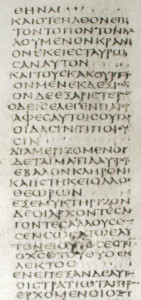Dr. Daniel Wallace is one of the foremost New Testament scholars in the world today. He is a native Californian, a pastor, and a former surfer. He transplanted to Texas and has taught for more than 28 years at Dallas Theological Seminary, where he is the professor of New Testament Studies. Dr. Wallace is also the Executive Director of the Center for the Study of the New Testament Manuscripts. He earned his B.A. at Biola University and went on to earn a ThM degree and PhD from Dallas Theological Seminary. His postdoctoral studies have taken him around the world from Australia to Africa. He has been part of writing, editing, or contributing to more than 24 books. He married his wife, Pati, 40 years ago and they have four sons and two granddaughters.
Speaking at Mars Hill (August 3, 2014) he shares important teaching on the origin of the New Testament and whether or not what we read in our Bible translations today is the same as what was written in the original manuscripts. If you or a friend have ever had doubts or questions about the validity of the New Testament, or the Bible in general, this is the sermon to watch.


 Dr. Daniel Wallace three come to mind: (1) If Matthew and Luke swallowed up Q in their writings, why would we expect to find any copies of Q? Or to put this another way, Luke says that he used more than one source, presumably more than one written source. If so, why haven’t we found it/them? The fact that we haven’t surely doesn’t mean that Luke was not shooting straight with us, does it? (2) Even the Gospel of Mark has few copies in the early centuries, yet it was endorsed as an official Gospel by Ireneaus. Yet this is a canonical Gospel, which apparently was regarded in some sense as authoritative before the end of the first century, or at the latest in the first decade or two of the second century, because of its association with Peter. Yet if there are only two copies of Mark in Greek before the fourth century still in existence (at least as far as what has been published to date), what chance do we have of finding a non-canonical gospel-source in the early centuries? And as the centuries roll on, the likelihood that such a document would continue to be copied becomes increasingly remote. (3) Apart from having the text of Q, as it has been reconstructed, what other criteria should scholars demand of such an alleged discovery? Do they expect the document to have a title such as “The Gospel according to Q”? That neologism won’t wash. Perhaps just such manuscripts have been discovered but were mislabeled. The burden of this short essay is to examine that possibility.
Dr. Daniel Wallace three come to mind: (1) If Matthew and Luke swallowed up Q in their writings, why would we expect to find any copies of Q? Or to put this another way, Luke says that he used more than one source, presumably more than one written source. If so, why haven’t we found it/them? The fact that we haven’t surely doesn’t mean that Luke was not shooting straight with us, does it? (2) Even the Gospel of Mark has few copies in the early centuries, yet it was endorsed as an official Gospel by Ireneaus. Yet this is a canonical Gospel, which apparently was regarded in some sense as authoritative before the end of the first century, or at the latest in the first decade or two of the second century, because of its association with Peter. Yet if there are only two copies of Mark in Greek before the fourth century still in existence (at least as far as what has been published to date), what chance do we have of finding a non-canonical gospel-source in the early centuries? And as the centuries roll on, the likelihood that such a document would continue to be copied becomes increasingly remote. (3) Apart from having the text of Q, as it has been reconstructed, what other criteria should scholars demand of such an alleged discovery? Do they expect the document to have a title such as “The Gospel according to Q”? That neologism won’t wash. Perhaps just such manuscripts have been discovered but were mislabeled. The burden of this short essay is to examine that possibility.